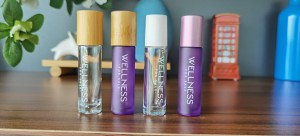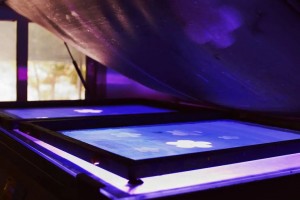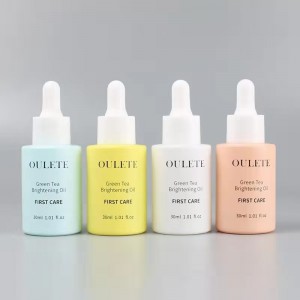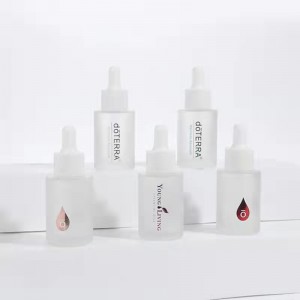The post-processing process of cosmetic packaging materials, such as silk screen printing of plastic bottles, glass bottles, lipstick tubes, air cushion boxes and other packaging materials, has a beautiful effect, but there are often some surface quality defects such as color difference, ink shortage, and leakage. How to effectively detect these silk screen products? Today, we will share the product quality description and conventional detection methods of packaging material silk screen processing. This article is compiled by shanghai rainbow package
01 Detection environment of silk screen
1. Luminosity: 200-300LX (equivalent to 40W fluorescent lamp with a distance of 750MM)
2. The product surface to be inspected is about 45 ° from the visual direction of the inspector (as shown in the figure below) for about 10 seconds
3. The distance between the visual direction of the inspector and the surface of the product to be inspected is as follows:
Grade A surface (external surface that can be directly viewed): 400MM
Class B surface (inconspicuous exterior): 500MM
Grade C surface (internal and external surfaces that are difficult to see): 800MM
02 Common defects of silk screen
1. Foreign matter: after silk screen printing, the coating film is attached with dust, spot or filiform foreign matter.
2. Exposed background: due to the thin screen at the screen position, the background color is exposed.
3. Missing printing: it is required that the screen printing position is not reached.
4. Blurred/broken wire; Poor silk screen printing results in uneven thickness of silk screen lines and patterns, blurring, and unconnected character lines.
5. Uneven thickness of silk screen: Due to improper operation of silk screen, the thickness of silk screen layer of dot line or pattern is uneven.
6. Misalignment: The screen printing position is offset due to inaccurate screen printing position.
7. Poor adhesion: the adhesion of silk screen coating is not enough, and it can be pasted off with 3M adhesive tape.
8. Pinhole: pinhole like holes can be seen on the film surface.
9. Scratches/scratches: caused by poor protection after silk screen printing
10. Heather/stain: non silk screen color is attached to the silk screen surface.
11. Color difference: deviation from standard color plate.
03. Silk screen reliability test method
We provide the following 15 test methods, and each brand user can test according to their own enterprise needs.
1. High temperature storage test
Storage temperature:+66 ° C
Storage time: 48 hours
Acceptance standard: the printing surface shall be free of wrinkles, blisters, cracks, peeling and no obvious change in color and luster after the sample is placed at room temperature for 2 hours after it is taken out of the furnace
2. Low temperature test
Storage temperature: – 40 ° C
Storage time: 48 hours
Acceptance standard: the printing surface shall be free of wrinkles, blisters, cracks, peeling and no obvious change in color and luster after the sample is placed at room temperature for 2 hours after it is taken out of the furnace
3. High temperature and humidity storage test
Storage temperature/humidity:+66 ° C/85%
Storage time: 96 hours
Acceptance standard: the printing surface shall be free of wrinkles, blisters, cracks, peeling and no obvious change in color and luster after the sample is placed at room temperature for 2 hours after it is taken out of the furnace
4. Thermal shock test
Storage temperature: – 40 ° C/+66 ° C
Cycle description: – 40 ° C~+66 ° C is a cycle, and the conversion time between temperatures shall not exceed 5 minutes, a total of 12 cycles
Acceptance standard: after the sample plate is placed at room temperature for 2 hours after being taken out of the furnace, check that there is no wrinkle, bubble, crack, peeling on the part and printing surface, and there is no obvious change in color and luster
5. Silk/pad printing adhesion test
Test purpose: to evaluate the adhesion of silk/pad printing paint
Test tool: 1. 3M600 transparent tape or transparent tape with viscosity greater than 5.3N/18mm
Test method: Paste 3M600 transparent tape on the printed font or pattern of the test sample to be tested, press it flat by hand based on the Six Sigma theory of quality, then pull the end of the tape 90 degrees from the test surface, and quickly tear off the same part of the tape for three times
Acceptance standard: the surface, silk/pad printing font or pattern shall be clear and legible without peeling
6. Friction test
Test purpose: to evaluate the adhesion of paint and silk/pad printing paint on the coated surface
Test equipment: eraser
Test method: fix the test piece and rub it back and forth with a vertical force of 500G and a stroke of 15MM. Each single stroke is once Silk/pad printing font or pattern, continuous friction 50 times
Acceptance standard: the surface shall be visually observed, the wear shall not be visible, and the silk/pad printing shall be legible
7. Solvent resistance test
(1) Isopropyl alcohol test
Drop 1ml of isopropanol solution onto the sample spraying surface or silk/pad printing surface. After 10min, dry the isopropanol solution with a white cloth
(2) Alcohol resistance test
Test method: soak 99% alcohol solution with cotton ball or white cloth, and then wipe back and forth for 20 times at the same position of the printed font and pattern of the sample at the pressure of 1kg and the speed of one round trip per second
Acceptance standard: after wiping, the printed words or patterns on the surface of the sample shall be clearly visible, and the color shall not lose light or fade
8. Thumb test
Conditions: more than 5 pcs. of test samples
Test procedure: Take the sample, place it on the printed picture with your thumb, and rub it back and forth for 15 times with the force of 3+0.5/-0KGF.
Experiment judgment: the printed pattern of the product cannot be nicked/broken/the ink adhesion is poor, otherwise it is unqualified.
9. 75% Alcohol Test
Conditions: more than 5PCS of test sample, white cotton gauze, 75% alcohol, 1.5+0.5/- 0KGF
Test procedure: tie the bottom of 1.5KGF tool with white cotton gauze, dip it in 75% alcohol, and then use the white cotton gauze to make 30 round trips on the printed pattern (about 15SEC)
Experimental judgment: the printed pattern of the product shall not fall off/have gaps and broken lines/have poor ink adhesion, etc. It is allowed that the color is light, but the printed pattern shall be clear and unambiguous, otherwise it is unqualified.
10. 95% Alcohol Test
Conditions: preparation of test samples of more than 5PCS, white cotton gauze, 95% alcohol, 1.5+0.5/- 0KGF
Test procedure: tie the bottom of 1.5KGF tool with white cotton gauze, dip it in 95% alcohol, and then use the white cotton gauze to make 30 round trips on the printed pattern (about 15SEC)
Experimental judgment: the printed pattern of the product shall not fall off/have gaps and broken lines/have poor ink adhesion, etc. It is allowed that the color is light, but the printed pattern shall be clear and unambiguous, otherwise it is unqualified.
11. 810 Tape test
Conditions: more than 5 pcs. of test samples, 810 tapes
Test procedure: fully stick 810 adhesive tape on screen printing, then quickly pull up the tape at a 45 degree angle, and measure three times continuously.
Experiment judgment: the printed pattern of the product shall not be chipped/broken.
12. 3M600 tape test
Conditions: more than 5 pcs. of test samples, 250 tapes
Experiment procedure: fully stick 3M600 tape to screen printing, and quickly pull up the tape at a 45 degree angle. Only one test is required.
Experiment judgment: the printed pattern of the product shall not be chipped/broken.
13. 250 Tape test
Conditions: more than 5 pcs. of test samples, 250 tapes
Test procedure: fully stick 250 adhesive tape to screen printing, quickly pull up the tape at a 45 degree angle, and conduct three consecutive times.
Experiment judgment: the printed pattern of the product shall not be chipped/broken.
14. Gasoline wiping test
Conditions: preparation of test samples above 5PCS, white cotton gauze, gasoline mixture (gasoline: 75% alcohol=1:1), 1.5+0.5/- 0KGF
Test procedure: tie the bottom of 1.5KGF tool with white cotton gauze, dip it in gasoline mixture, and then go back and forth on the printed pattern for 30 times (about 15 SEC)
Experimental judgment: the printed pattern of the product shall be free of falling off/notch/broken line/poor ink adhesion, and the color can be allowed to fade, but the printed pattern shall be clear and unambiguous, otherwise it is unqualified.
15. N-Hexane rubbing test
Conditions: preparation of test samples above 5PCS, white cotton gauze, n-hexane, 1.5+0.5/- 0KGF
Test procedure: bind the bottom of 1.5KGF tool with white cotton gauze, dip it in n-hexane solution, and then go back and forth on the printed pattern for 30 times (about 15 SEC)
Experimental judgment: the printed pattern of the product shall be free of falling off/notch/broken line/poor ink adhesion, and the color can be allowed to fade, but the printed pattern shall be clear and unambiguous, otherwise it is unqualified.
Shanghai rainbow industrial co.,ltd provides one-stop solution for cosmetic packaging.
If you like our products, you can contact us, Website: www.rainbow-pkg.com
Email: Vicky@rainbow-pkg.com
WhatsApp: +008615921375189
Post time: Nov-14-2022





